 What’s the difference between the different varieties of onions?
What’s the difference between the different varieties of onions?
Can they be used interchangeably?
Scallions, green onions and spring onions…aren’t they all the same?
Many of us probably just grab whichever onion is on sale, or the first one we see, and don’t think much about it, but have you ever wondered “what’s the difference?” We wanted to try to shed a little light on this. Plus, see how we healthified the notorious “Bloomin’ Onion”…dipping sauce included!
What are the main kinds of onions and when should you use each one?
All varieties of onions are members of the allium family, which also includes garlic, chives, shallots, leeks and spring onions. There are actually thousands of species in this group…there are even flowering varieties. We will try to provide info on the most common (and our favorite) members of this onion family!
The most common, of course, are red, white, and yellow onions. While these onions vary in color, flavor and texture, they can often be substituted for one another…especially when cooking. You will probably have your personal preferences, but it’s interesting and fun to experiment with different varieties in your cooking!
The Yellow Onion:
 This is America’s favorite onion and makes up 90% of the onions grown in the U.S. Most commonly used in cooking, the yellow onion is a great “go-to” onion.
This is America’s favorite onion and makes up 90% of the onions grown in the U.S. Most commonly used in cooking, the yellow onion is a great “go-to” onion.
With its yellow/brown papery skin, the yellow onion is not too strong, which makes it ideal for most recipes. Because it becomes sweeter the longer it cooks, it is a great choice to use in the slow cooker and for making caramelized onions. They work great for our Good For You French Onion Soup!
Yellow onions tend to have the highest sulfur content, giving them the highest “tear factor” and the most powerful smell and aroma. For ideas how to cure (or at least improve) this “tear factor,” see our coaching tip!
The White Onion:
 With its white papery skin, the white onion is slightly milder and can be slightly sweeter than the yellow onion. Because it is milder in flavor, the white onion can more easily be eaten raw, but can also easily be substituted for yellow onions in recipes.
With its white papery skin, the white onion is slightly milder and can be slightly sweeter than the yellow onion. Because it is milder in flavor, the white onion can more easily be eaten raw, but can also easily be substituted for yellow onions in recipes.
White onions work well chopped in salads, thinly sliced on sandwiches and are great for the Curried White Fish Creole, Baked Onion Rings, and Sausage, Apple and Onion Chicken Skillet!
The Red Onion:
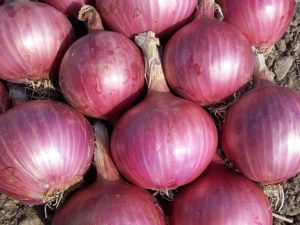 With its reddish-purple papery skin and reddish color, the red onion tends to be the most mild and sweet variety. This is why red onions work great sliced raw in salads, salsas and guacamole, or added to burgers and sandwiches.
With its reddish-purple papery skin and reddish color, the red onion tends to be the most mild and sweet variety. This is why red onions work great sliced raw in salads, salsas and guacamole, or added to burgers and sandwiches.
While red onions are mild and sweet, they can also have a bite! If you get a red onion that seems too potent to eat raw, you can easily tame it down by letting it soak in a bowl of cool water for 10-15 minutes before eating. Because red onions have a mild flavor, they can be used in a variety of recipes, but some say they prefer to use yellow or white onions when cooking since they provide a stronger onion flavor. One place red onions are ideal…for pickling! It doesn’t have to take a lot of time either — see our coaching tip on quick pickling and then try our Green Beans with Pickled Red Onions or Panzanella Salad with Pickled Radishes and Onions!
Green Onions (or Scallions):
 Whether these are called green onions or scallions may just be based on where you live! Long and thin, green onions are white at the bottom and dark green at the top and typically sold in bunches. Once you trim the ends off, you can slice or chop them and eat the entire green onion.
Whether these are called green onions or scallions may just be based on where you live! Long and thin, green onions are white at the bottom and dark green at the top and typically sold in bunches. Once you trim the ends off, you can slice or chop them and eat the entire green onion.
They have a very slight onion taste with a little crunch and work great in a variety of dishes.
If they are cooked or added to a stir-fry, they don’t need to cook long at all…only a couple of minutes…so it is best to add them at the end or eat them raw as a topping. The Scallion Kimchi and Seared Scallions with Poached Egg are both fantastic!
Spring Onions:
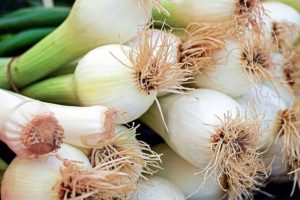 These look exactly like green onions or scallions, but have a bigger white bulb at the bottom. Also typically sold in bunches, spring onions are really just very young onions. They are pulled out of the ground very early when they still have a thin skin and mild flavor.
These look exactly like green onions or scallions, but have a bigger white bulb at the bottom. Also typically sold in bunches, spring onions are really just very young onions. They are pulled out of the ground very early when they still have a thin skin and mild flavor.
They tend to be slightly more spicy when eaten raw, but get sweeter when cooked. They can easily be used interchangeably with green onions or scallions in various recipes.
Leeks:
 There was a time when we had no idea what leeks were! (Honestly they sounded like something slimy and found in a jar…definitely sounded like something we had no use for!) Were we wrong! Leeks are just like really big green onions, and an early Spring variety is sometimes referred to as ramps.
There was a time when we had no idea what leeks were! (Honestly they sounded like something slimy and found in a jar…definitely sounded like something we had no use for!) Were we wrong! Leeks are just like really big green onions, and an early Spring variety is sometimes referred to as ramps.
The white and light green portion of leeks is the edible part and they are tender and sweet. They are typically not eaten raw, but are delicious when added to various meals such as stir-fries, soups, frittatas, and our Braised Leeks and Scallops on Creamy Leeks are both amazing! They are even great on the grill! There is a trick to washing leeks because dirt can get stuck in between the layers of the leek. You can slice them and place in a colander, or if leaving the leeks in long pieces then slice them lengthwise, rinse to remove the dirt, then pat dry and they are ready to use in your recipe. See our coaching tip for more about leeks!
Shallots:
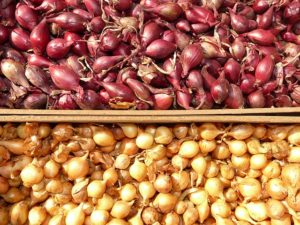 Slightly milder than yellow or red onions, shallots are very small onions, with a pinkish-orange papery skin. Shallots add a great onion flavor, with a hint of garlic, and have a great way of incorporating themselves into a dish…this is why many chefs use them in their restaurants.
Slightly milder than yellow or red onions, shallots are very small onions, with a pinkish-orange papery skin. Shallots add a great onion flavor, with a hint of garlic, and have a great way of incorporating themselves into a dish…this is why many chefs use them in their restaurants.
They are especially handy to use when you want the savory onion flavor without larger chunks of onion. Shallots can typically be found near the other onions at the store…and your local farmers market is a great place to buy shallots in bulk if they are available. Try crispy shallots on top of the Chopped Kale Salad with Maple Almond Vinaigrette!
Cippolini:
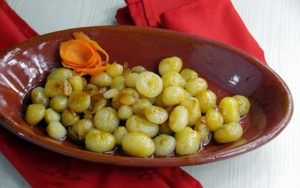 This is one of our favorite varieties of onions. These look like small squat-shaped yellow onions (almost like someone stepped on them!) and cippolini means “little onion” in Italian. They have a pale yellow thin papery skin, which can be a little tricky to peel but totally worth the effort!
This is one of our favorite varieties of onions. These look like small squat-shaped yellow onions (almost like someone stepped on them!) and cippolini means “little onion” in Italian. They have a pale yellow thin papery skin, which can be a little tricky to peel but totally worth the effort!
Cippolini onions are really sweet so if you are looking for the perfect onion to caramelize, this is it! Or try roasting them whole in the oven for about 30 minutes with a little olive oil, salt and pepper…mouthwatering!
How do you store onions?
Onions like it cool, dry, and dark. Stored properly, they can last for weeks or months. Avoid storing onions in plastic bags, as this can cause them to mold and decay faster. Storing in open paper bags or in mesh bags (or bags with holes in them) works well.
Onions will do best stored outside the refrigerator, although the refrigerator is an option if you don’t have another cool, dry, dark location. If you do store your onions in the refrigerator, don’t store them next to your potatoes…actually, it is best to keep them separate from other produce so the produce doesn’t take on the onions’ flavor. Once the onion is cut, it should be refrigerated. Also, scallions are best stored in the fridge.
The Famous Appetizer Made Healthier and Still Delicious!
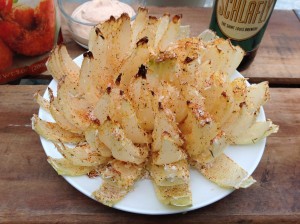 It has been years since we have indulged in the famous restaurant “Bloomin’ Onion,” but we gave this popular appetizer a healthy makeover at home and it’s delicious! Of course, the dipping sauce is optional, but highly recommended — and this version is much better for you and still tastes great!
It has been years since we have indulged in the famous restaurant “Bloomin’ Onion,” but we gave this popular appetizer a healthy makeover at home and it’s delicious! Of course, the dipping sauce is optional, but highly recommended — and this version is much better for you and still tastes great!
Give our Healthified Bloomin’ Onion with Spicy Dipping Sauce a try and see what you think!
We hope this helps navigate the perplexing world of onions…and helps you try some new options!
 LEARN MORE ABOUT THE NAPKIN!
LEARN MORE ABOUT THE NAPKIN!
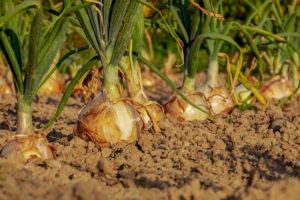
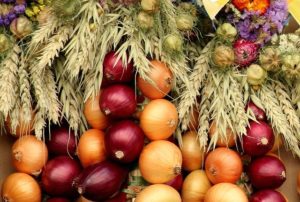
Leave A Comment